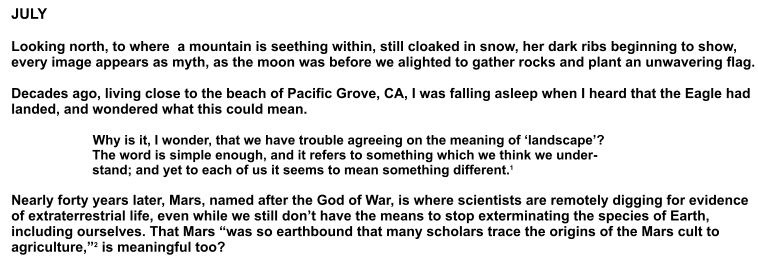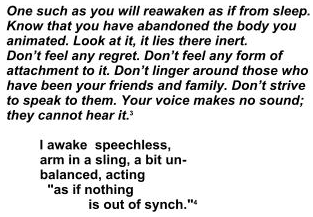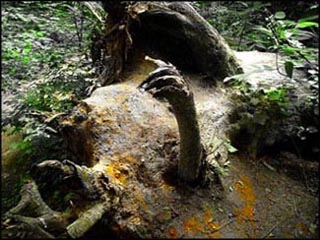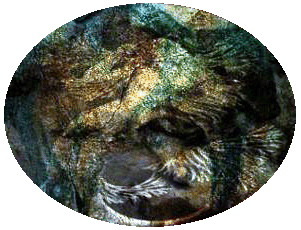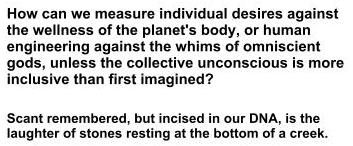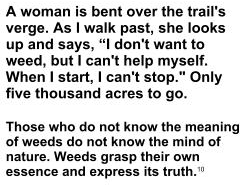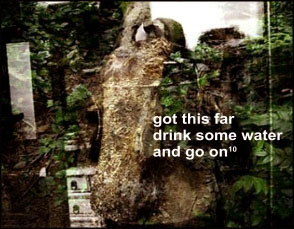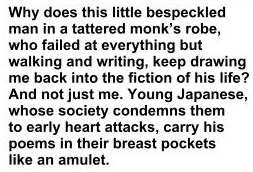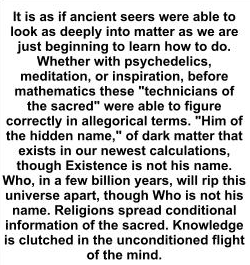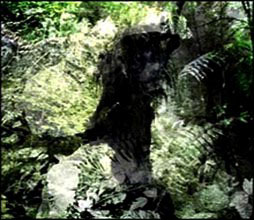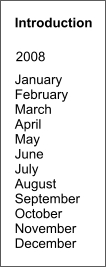
|
|
July 3. Last night, I wrote "NO," in black waterproof marker detailing the shoulder not to be opened. Now the anesthesiologist, oriented to the jugular, is marking points for the nerve blocks to flow in. I ask if he specialized in knocking people out because his patients can't talk back. He laughs, and says, "It's a long story," as a smiling nurse slips the stem of a somniferous poppy into my arm and conscious makes its exit.
5. As I remove the bandages and count three incisions covered with steri-strips, I wonder what caused the first rude exposure of human viscera, and why do we need to know first causes. There are perhaps hundreds of myths describing the beginning of the universe. From turtles to a superhuman God most menhirs are unshaped stones. The majority were not therefore intentionally designed and constructed as physical objects to represent a particular set of ideas. This suggests that they did not signify or represent anything in conventional semiotic terms and so we cannot reduce their experience to the level of language. They took their meanings in relation to a Big Bang and colliding branes. Anthropologists search for evidence of who were the first humans to reach North America, while fundamentalist Amerindians believe their ancestors have been here forever. It seems to me that it is not a matter of reconciling scientific theory with religious belief, but of coaxing each limb of the psyche into a more flexible place. As—
7. With left arm sweating, its humerus in a sling pressing into the opposite shoulder, I return books to the library, borrow more, pickup groceries, carrying the load home with the one functioning arm. Behind my worktable is a four-armed Shiva dancing to a dirge that melts glaciers down to rime, sends rivers into a rage, spins the atmosphere into hurricanes, tornadoes, and unleashes Typhoon, erratic son of Gaia, the Earth, and Tartaros, the deepest of hells, born with a feathered body, with shoulders that carry one hundred heads of a black-tongued dragon, and an overheated temper that burst forests into flames. Shiva also presents Judaism's seven days of mourning, the shadow side of the biblical creation myth. While the Hindu God dances whole worlds into collapse, a Jewish family sits shiva on wooden boxes, brooding over the death of one of its own. Both Shiva and shiva are engaged in an "inevitable aspect of love"6
There are dangers when inclusiveness is projected. As with the "Whole Earth" fantasy that became popular when pictures of our planet arrived from outer space. Forty years after the initial euphoria of seeing the "blue-green jewel" that is our home in the universe, we remain a fragmented civilization made up of paranoid nation-states rubbing against each other and continuously re-lighting the maelstrom of war. Inclusiveness would begin when children are taught to recognize their interdependency with all sentient and non-sentient beings. With most scientists warning that there's not much time left for us to learn how to restore the jewel to the lotus, it is not reasonable to believe that this can be achieved in time.
8. Physical therapy on my shoulder begun today. The road back, but back to where? Not to where I was before. We discuss what's been flensed and what's been sutured, the sutras being the oldest psychology texts. Arm splayed forward, Let go! Arm moved over the chest to the side, Let go! Arm raised behind back. Let go! A speck of blood from one incision. But no infection.
11. A friend phoned to say, "Happy Birthday." I replied, "Wasn't that last year?" Birthdays, anniversaries, holidays, holy days... repetition and ritual cork the imagination, whose nature is free-flowing. How many times must Christ be born and die before you can say, "Rest in peace"? How many times must the Buddha be slain before you know who you are? There are so many deities, the Plataeans would set out pieces of boiled flesh and keep a sharp watch on the crows, which came flocking to them; the other birds did not trouble them in the least. They observed the crow which pounced on the flesh and the tree on which he perched. Then they felled the tree on which he perched, and made the daedalum, a wooden image, out of so many wondrous myths. Trees oversee the commotion, sword ferns guard the steep incline. When I was one-year-old we went to the mountains, spending that summer, and several others, near where many years later the Woodstock Festival was held. There were plants, animals, and a pond by which I found the first girl who enchanted me. There was also a large boulder with a small entrance, through which I crawled to a room of ancient artifacts. Did this really happen? At the end of the summer, I reluctantly returned with my family to the city. But cities have mysteries too.
14. Neo-Jungian writer, Peter Bishop, points out that to imagine ourselves as what Marx called a "species-being," means that we can also imagine the extinction of our species along with the extinction of other species. With climate change upon us, it is not only one's individual death that is faced, "but the very ground of imagining is now threatened with extinction."8
In the spirit of the catastrophe, it is no longer, "How will I be remembered?" It is, "How will I be remembered?" In a digital world, that the software is accessible backwards in time is more important than the location the archive assumes. But if our species becomes extinct, can our machines survive long enough for another intelligent species to evolve, or land, and recover the archive?
17.
In mid-summer, the creek lazes and dreams with its mind of water. Tall weeds lean over the trail, and rocks deliver messages to my soles. I've been thinking about the difference between information and knowledge. Almost two decades ago, I did museum show with the photographer Patrick Nagatani.11 Referring to one of his forty large format photographs, he said, "I just wanted to make a beautiful picture." Because of the ugliness of our subject—the history and proliferation of nuclear weapons research and development, along with uranium mining and toxic waste storage, in the state where the atomic bomb was born and tested in the atmosphere—the word "beauty" shocked me into cynicism. Only now am I beginning to see what Nagatani saw: To rise to the level of Knowledge, information must contain a significant amount of Beauty. Peter Bishop put it this way: "Perhaps the great question of our time is less the alienation from 'nature' than from 'beauty.'"8
19. Looking north, fires are climbing Mt. Adams, itself seething within. St. Helens' darkness is lighted by a generous sun. A bird crosses my vision, and I think of Peter Matthiessen. "A bird has flown north toward Tibet," he wrote, "a small white falcon. In vertigo caused by exhaustion and the glare, staring straight up at this heraldic bird, I gasp for breath; there is no white falcon in the Himalayas."12
21. Coffee this afternoon with the poet William Witherup, visiting from Seattle. We first met forty years ago in San Francisco's Haight Ashbury District, Bill appearing near the God's Eye Theater, the experimental theater I was helping to build, wearing his infamous white suit. Camping in California's Ventana Wilderness, my stash of food had been stolen by a oneiric raccoon, and long rows of poison oak were beginning to tattoo my skin. So I went to visit Bill. After dinner, we drove to Bixby Creek, where he was renting a cabin owned by Lawrence Ferlinghetti, the same cabin that appears in Jack Kerouac's novel, Big Sur. We talked through the night, as the ghosts of the Beat Poets swirled around the initials they had carved into the windowsill. When dawn arrived, we stepped outside into "a lake of pure light."
Today, Bill showed me his toy cell phone. A candy dispenser, it looks genuine enough that on public transportation, when someone is loudspeaking into their cell phone, Bill begins his own superficial conversation into the childish-looking device. This ingenious piece of performance art reminds me of when Rodin was a continuous sculptor who had naked men women horses dogs cows wandering through his studio, and when he ‘saw’ something he would work the clay he always held in his hand into a sketch. He would then save them. Sometimes he would have his helpers—Brancusi, Mailot, Modigliani, Hoffman—enlarge them and cast them in plaster. He kept these fragments—legs, arms, heads, hands, ears—in drawers and boxes in his studio, and at times, on a subway train, with the faces of commuters hidden behind newspapers, Jack Kerouac cut a hole in his copy of The New York Times, stuck his face through it, and read the passengers instead. 24. Although I feel lucky to be living in a city with a forest in its midst, I also know that its survival falls within the city's budget. And that it is not wild, but managed. When the Anglican bells outside my apartment's windows announce the hour, I imagine that God is a compass that always points to itself. No wonder I favor wilderness! Its paths embrace the earth's permutations, dry sunny hills and moist shadowy valleys, the long curves of its neck, the length of its legs splitting into pairs that take one somewhere else. "Our true religion is a monotheism of consciousness, a possession by it, coupled with a fanatical denial of the existence of fragmentary autonomous systems."15
25. Lunch with Don Fredericksen, Professor of Film Studies at Cornell, Tibetan Buddhist, Jungian psychotherapist. In a recently published essay, he quotes German filmmaker Werner Herzog:
Fredericksen comments: "This notion of adequate images, of adequacy for 'living by', is crucial; it issues into questions about adequate narratives, about the stories adequate to the sustaining of human life in ways that do not close off the symbolic register."18 He mentioned to me that the poet Muriel Rukeyser wrote that "the universe is made of stories, not of atoms." As we know there was just the right amount of everything on this planet for life to emerge, now there must also be enough stories to sustain the culture we've evolved. But can it be sustained with the symbolic register shrinking in adverse proportion to the growth of corporate profits? We also know that the dinosaurs didn't fade away like old soldiers. There was a sudden collapse.
26. That we and other primates dream is a clue to the origins of consciousness? I wonder, too, if the brain's morphology can tell us why we experience the world as we do. Is neuroscience so involved in function that it's missing the meaning of form? In my early 20s I read Sartre's Being and Nothingness because I understood that anything easily understood was not worth looking into. I measured quality by difficulty. I inhaled Being and Nothingness more than I read it. In several places in his book on war, James Hillman mentions that the cult of Mars was relegated to a field outside of Rome. Although the god's relationship to the military is obvious, how does he relate to the tilling of the earth? "Suppose the earth, Mother Earth if you prefer, demands blood. Suppose the slaughtered are like offered animals, their heads held down so the blood runs through a trough hollowed into stone, the pouring out of blood like a libation onto the earth..."19 Wars are about sacrifice. Not the sacrifice of the invader, as we are led to believe by the popular media, but of the invaded, who is cleared like a failed crop in order to plant and cultivate the victor's more righteous seeds. However, most importantly, "the transformations of culture do not take place in history, they take place in myth."20 Mars plows through freshly conquered land wearing the same arrogant grin he cultivated in the Neolithic, when the first fields were planted, and defended. Assured that the current bloodletting pays homage to him, Mars employs the high-fives, the manly pats on the back, the boy from Texas who whoops, "I just killed me an I-raqi!"
27. There
is no lesson more profound than the hollow stump of what
was once a magnificent tree. It is what Prince Siddhartha
saw when for the first time an aged man appeared by the
side of the road, and changed the direction of his life.
It hasn't rained for weeks, the sky a gray slate of clouds
sailing in from the sea, from a porthole that every day
framed the same
28. Woke up thinking about my conversation with Don Fredricksen. We had briefly discussed filmmaking in Poland, one of his scholarly interests. I had seen Krzysztof Kieslowski's "The Decalogue" with a group of people from Oregon Friends of C.G. Jung, and couldn't remember what we had called the silent man who passes through the ten films. I thought we had called him The Traveler, but now I remember that it was The Watcher. When I think of the Traveler, it is of Star Trek: The Next Generation, where he is "a highly advanced humanoid from Tau Alpha C. The Traveler is exceptionally skilled mentally, and is able to make a bridge between space, time and thought through which he and presumably those of his kind travel throughout the galaxy."21 The bridge is the Traveler's link to the spirit. In a conversation I had a few years ago with the professor of religion, Jenny Yates, she remarked that "The root of pontiff via pons links to the bridge, as in the brain. But the root of bridge is 'brow' as in third eye."22 This connects us to the Watcher.
30. My shoulder has a mind of its own. Almost daily, it's been adding new articulations to our dance. I'm eager to return to my familiar self, yet deny that this is "healing." Televangelists grab the lame and, miraculously, they walk again. Are they healed, or confused? Healing is not an act of faith, but an alteration of perspective.
1- Jackson,
J.B. “The Word Itself.” In, Discovering the
Vernacular Landscape. New Haven, CT., 1984. |
